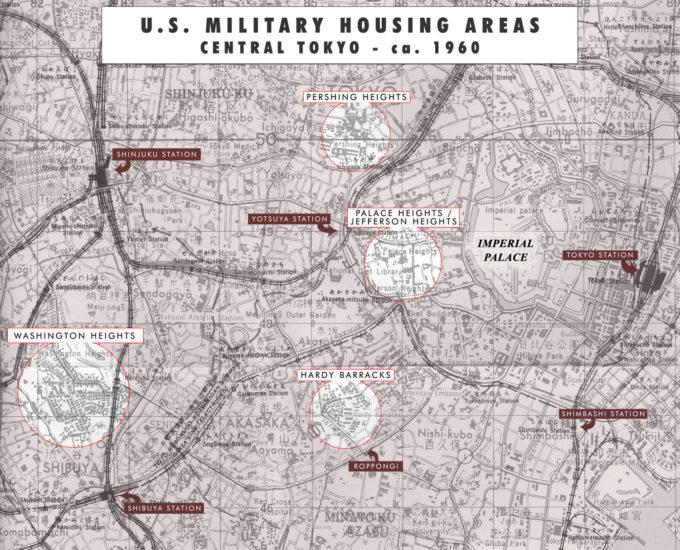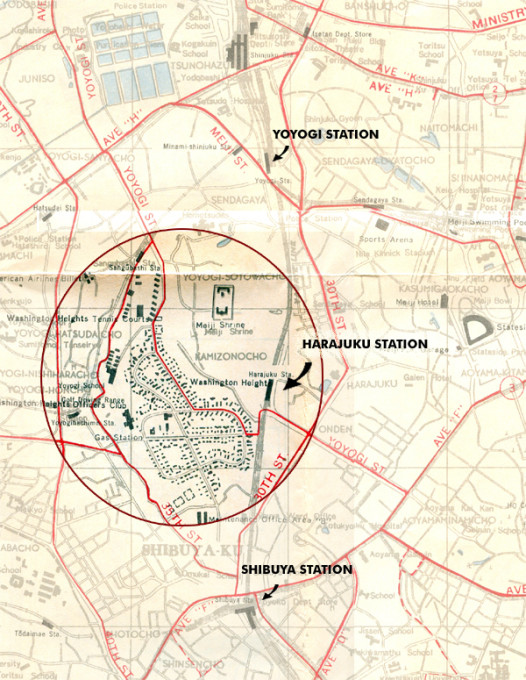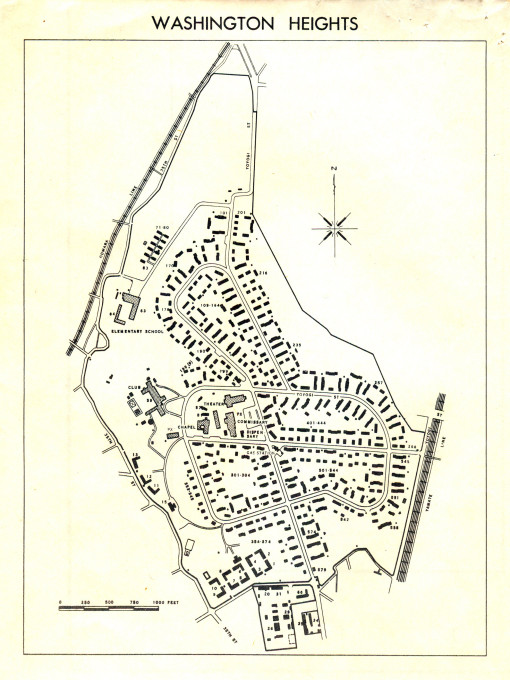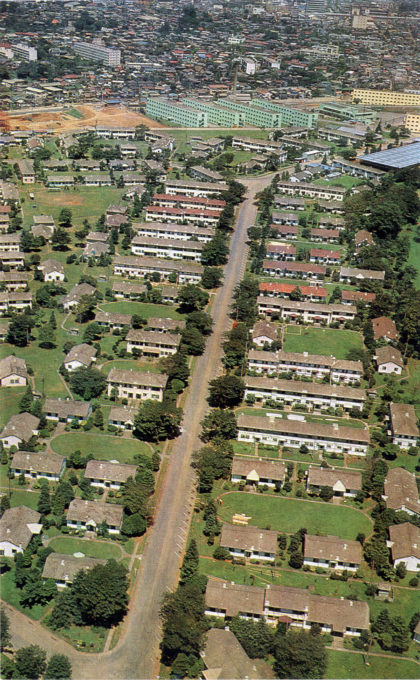
Olympic Village née Washington Heights Housing Complex, 1964. The former US military housing estate, the largest in Japan in the years immediately after the Occupation, was closed in 1962 and the property returned to Japan but was repurposed for athlete housing during the 1964 Summer Olympic Games. Properties from other large military housing areas in the center of Tokyo were also returned to Japanese ownership by the mid-1960s, including Pershing Heights, near Ichigaya Station; and Jefferson Heights and Palace Heights, near Yotsuya Station, the Diet (Parliament) building and the U.S. embassy. Hardy Barracks, near Roppongi, would be returned in the late ’60s to Japan Self-Defense Forces control.
“They still come back. Some peek through the fence – others just walk around and look.
“This is the way a Japanese official at the Tokyo Olympic Village – the former Washington Heights U.S. housing area – describes the frequent visits of American families who gave up their homes in the ‘little American village’ to make way for the 1964 Olympic Games.
“Now, with the Olympics over, the village is being torn down to make way for the Yoyogi Forest Green Park – but some American families still seem to be concerned with the future of the former housing area.
“… A 500-block community was torn down in order to build the huge Olympic Gymnasium and swimming pool, and a 300-block area was renovated to house the 7,200 athletes and officials who particpated in the Games. Now, with the Games over, the spokesman said that the remaining facilities, with the exception of one family unit … are being leveled for the multi-million dollar park.
“He said that Yoyogi Forest Green Park will cover most of the 232-acres that once housed an overseas American neighborhood in the center of the city. The spokesman said the new park, scheduled to be completed by summer, 1968, will adjoin the tree-covered ground of Meiji Shrine, located along one side of the former U.S. housing area. Japan is preserving one family unit to commemorate the role the village played in the 1964 Olympics, the official said.
“The lone house, he said, will also serve as a symbol of goodwill and friendship between the Japanese and American communities.”
– “Washington Heights is Gone But the Memory Lingers On”, Stars & Stripes, Sept. 21, 1965
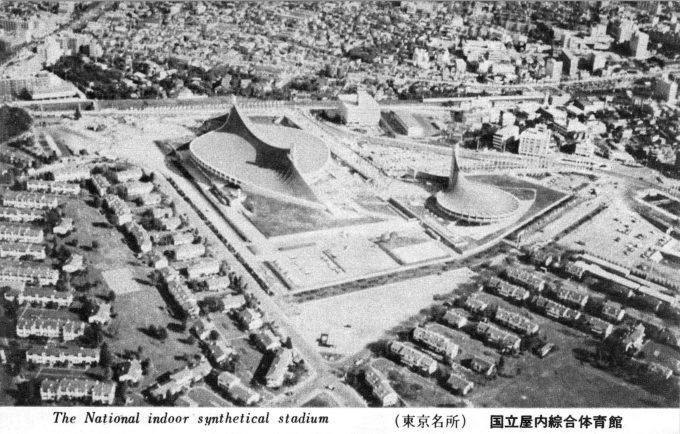
Aerial view of the Olympic stadiums at Yoyogi, with the remaining Washington Heights housing (foreground) used as athlete’s dormitories, 1964.
“In July 1946, [GHQ’s] engineering division published guidelines for housing that reflected the ‘standard American community life.’ Single and two-story duplex units ranging between 890- and 1900-square-feet were to accommodate soldiers ranking from lieutenant to brigadier general along with their War Department civilian counterparts.
“After Japanese structures in the area were razed, construction began on a ninety-two-hectre parcel of land just [south] of Meiji Shrine. In a matter of months, Yoyogi parade ground, used since 1905 for military drills, had become ‘Washington Heights’, a gated community of several hundred housing units that resembled many an early postwar American suburb.
“In addition to the houses, the self-contained community featured a chapel, movie theater, recreation hall, library, fire and gas stations, schools, and a shopping center with a commissary, dispensary, and barber/beauty shops.”
– Cartographic Japan: A History in Maps, edited by Karen Wigen, Sugimoto Fumiko & Cary Karacas, 2016
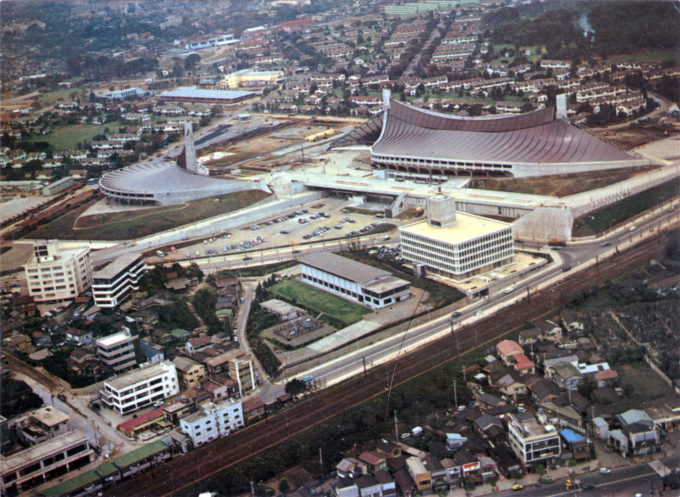
Aerial view of the Olympic swimming/diving and basket stadium venues, and Olympic Village, Yoyogi, 1964. In the distance can be seen the former Washington Heights housing area, used as the Olympic Village by athletes during the Olympics Games after its return to Japan.
See also:
1964 Summer Olympic Venues
Aoyama Parade Ground, c. 1905
From the wiki: “Washington Heights was a United States Armed Forces housing complex located in Shibuya, Tokyo during the occupation of Japan by Allied forces. Constructed in 1946, it remained in operation until 1962, by which point all land had been returned to Japanese control. Today, the site encompasses Yoyogi Park, Yoyogi National Gymnasium, the NHK Broadcasting Center, and other facilities.
“Covering an area of 924,000 square meters, Washington Heights was home to 827 housing units for United States Army Air Force and, later, Air Force families. It also hosted support facilities, including schools, churches, theaters, shops, and officers’ clubs. Japanese citizens were not permitted to enter the area, which was fenced in with multiple gates.
“Before the surrender of Japan, the area was used as a parade ground by the Imperial Japanese Army. The U.S. military ordered the construction of the Washington Heights complex by the Japanese government, and maintained control of it after the signing of the Treaty of San Francisco. Although the treaty returned Japanese sovereignty in late April 1952, military forces would remain, including those housed at Washington Heights.
“The Treaty of Mutual Cooperation and Security between the United States and Japan, signed in 1960, determined that Washington Heights would remain in operation. The following year, though, the land was deemed necessary for construction of facilities connected with the 1964 Summer Olympics. The transfer was completed 1962-1964, with the Japanese government bearing the full amount of relocation expenses for U.S. military families moving to Chofu Airport.
“A number of the former military barracks were used as athlete housing during the Games. Other athletes were housed in a newly constructed facility that later became the National Olympics Memorial Youth Center. After the Olympics, nearly all the military housing was razed, with one house – that used by the Dutch Olympic team – remaining in Yoyogi Park in commemoration of the Olympics.”
More information/photos of Washington Heights (1946-1962) is available here:
Forgotten History #2 Yoyogi Park’s Washington Heights


